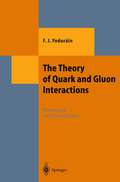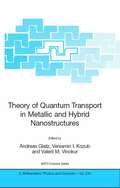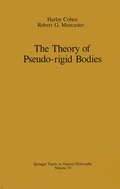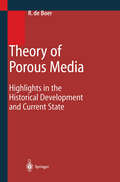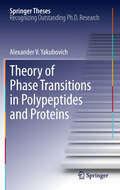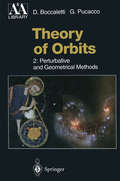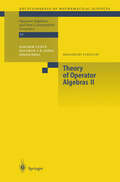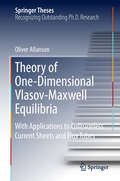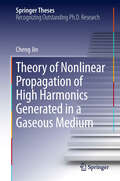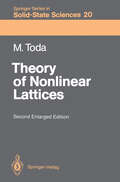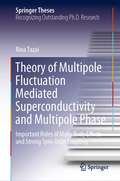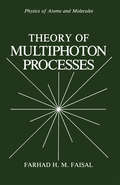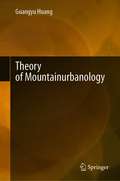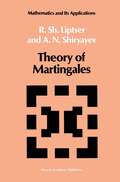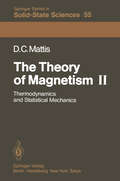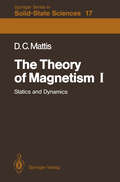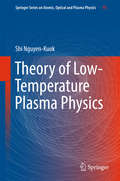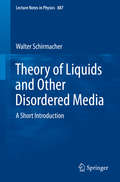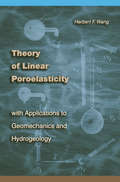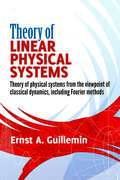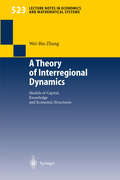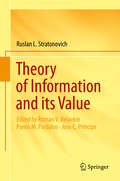- Table View
- List View
The Theory of Quark and Gluon Interactions (Theoretical and Mathematical Physics)
by Francisco J. YndurainFirst published in 1983, this book has become a classic among advanced textbooks. The new fourth edition maintains the high standard of its predecessors. The book offers basic knowledge of field theory and particle phenomenology. The author presents the basic facts of quark and gluon physics in pedagogical form. Explanations of theory are supported throughout with experimental findings. The text provides readers with sufficient understanding to follow modern research articles. This fourth edition presents a new section on heavy quark effective theories, more material on lattice QCD and on chiral perturbation theory.
The Theory of Quark and Gluon Interactions (Theoretical and Mathematical Physics)
by Francisco J. YndurainFirst published in 1983, this book has become a classic among advanced textbooks. The new fourth edition maintains the high standard of its predecessors. The book offers basic knowledge of field theory and particle phenomenology. The author presents the basic facts of quark and gluon physics in pedagogical form. Explanations of theory are supported throughout with experimental findings. The text provides readers with sufficient understanding to follow modern research articles. This fourth edition presents a new section on heavy quark effective theories, more material on lattice QCD and on chiral perturbation theory.
Theory of Quantum Transport in Metallic and Hybrid Nanostructures (NATO Science Series II: Mathematics, Physics and Chemistry #230)
by Andreas Glatz Veniamin I. Kozub Valerii M. VinokurThe book reflects scientific developments in the physics of metallic compound based nanodevices presented at the NATO-sponsored Workshop on nanophysics held in Russia in the summer of 2003. The program tackles the most appealing problems. It brings together specialists and provides an opportunity for young researchers from the partner countries to interact with them and get actively involved in the most attractive and promising interdisciplinary area of contemporary condensed matter physics.
The Theory of Pseudo-rigid Bodies (Springer Tracts in Natural Philosophy #33)
by Harley Cohen Robert G. MuncasterThis monograph concerns the development, analysis, and application of the theory of pseudo-rigid bodies. It collects together our work on that subject over the last five years. While some results have appeared else where, much of the work is new. Our objective in writing this mono graph has been to present a new theory of the deformation of bodies, one that has not only a firm theoretical basis, but also the simplicity to serve as an effective tool in practical problems. Consequently, the main body of the treatise is a multifaceted development of the theory, from foundations to explicit solutions to linearizations to methods of approximation. The fact that this variety of aspects, each examined in considerable detail, can be collected together in a single, unified treat ment gives this theory an elegance that we feel sets it apart from many others. While our goal has always been to give a complete treatment of the theory as it now stands, the work here is not meant to be definitive. Theories are not entities that appear suddenly one day and thereafter stand as given. Rather, they must mature and grow with time and experience. Our development is more correctly a beginning, tempting others to explore, appraise, and modify its features so as to produce something better.
Theory of Porous Media: Highlights in Historical Development and Current State
by Reint de BoerThis is a consistent treatment of the material-independent fundamental equations of the theory of porous media, formulating constitutive equations for frictional materials in the elastic and plastic range, while tracing the historical development of the theory. Thus, for the first time, a unique treatment of fluid-saturated porous solids is presented, including an explanation of the corresponding theory by way of its historical progression, and a thorough description of its current state.
Theory of Phase Transitions in Polypeptides and Proteins (Springer Theses)
by Alexander V. YakubovichThere are nearly 100 000 different protein sequences encoded in the human genome, each with its own specific fold. Understanding how a newly formed polypeptide sequence finds its way to the correct fold is one of the greatest challenges in the modern structural biology. The aim of this thesis is to provide novel insights into protein folding by considering the problem from the point of view of statistical mechanics. The thesis starts by investigating the fundamental degrees of freedom in polypeptides that are responsible for the conformational transitions. This knowledge is then applied in the statistical mechanics description of helix↔coil transitions in polypeptides. Finally, the theoretical formalism is generalized to the case of proteins in an aqueous environment. The major novelty of this work lies in combining (a) a formalism based on fundamental physical properties of the system and (b) the resulting possibility of describing the folding↔unfolding transitions quantitatively. The clear physical nature of the formalism opens the way to further applications in a large variety of systems and processes.
Theory of Orbits: Perturbative and Geometrical Methods (Astronomy and Astrophysics Library)
by Dino Boccaletti Giuseppe PucaccoHalf a century ago, S. Chandrasekhar wrote these words in the preface to his 1 celebrated and successful book: In this monograph an attempt has been made to present the theory of stellar dy namics as a branch of classical dynamics - a discipline in the same general category as celestial mechanics. [ ... ] Indeed, several of the problems of modern stellar dy namical theory are so severely classical that it is difficult to believe that they are not already discussed, for example, in Jacobi's Vorlesungen. Since then, stellar dynamics has developed in several directions and at var ious levels, basically three viewpoints remaining from which to look at the problems encountered in the interpretation of the phenomenology. Roughly speaking, we can say that a stellar system (cluster, galaxy, etc.) can be con sidered from the point of view of celestial mechanics (the N-body problem with N» 1), fluid mechanics (the system is represented by a material con tinuum), or statistical mechanics (one defines a distribution function for the positions and the states of motion of the components of the system).
Theory of Orbits: Volume 1: Integrable Systems and Non-perturbative Methods (Astronomy and Astrophysics Library)
by Dino Boccaletti Prof. Giuseppe PucaccoHalf a century ago, S. Chandrasekhar wrote these words in the preface to his l celebrated and successful book: In this monograph an attempt has been made to present the theory of stellar dy namics as a branch of classical dynamics - a discipline in the same general category as celestial mechanics. [ ... J Indeed, several of the problems of modern stellar dy namical theory are so severely classical that it is difficult to believe that they are not already discussed, for example, in Jacobi's Vorlesungen. Since then, stellar dynamics has developed in several directions and at var ious levels, basically three viewpoints remaining from which to look at the problems encountered in the interpretation of the phenomenology. Roughly speaking, we can say that a stellar system (cluster, galaxy, etc.) can be con sidered from the point of view of celestial mechanics (the N-body problem with N » 1), fluid mechanics (the system is represented by a material con tinuum), or statistical mechanics (one defines a distribution function for the positions and the states of motion of the components of the system).
Theory of Operator Algebras III (Encyclopaedia of Mathematical Sciences #127)
by Masamichi TakesakiFrom the reviews: "These three bulky volumes [EMS 124, 125, 127] […] provide an introduction to this rapidly developing theory. [...] These books can be warmly recommended to every graduate student who wants to become acquainted with this exciting branch of mathematics. Furthermore, they should be on the bookshelf of every researcher of the area." Acta Scientiarum Mathematicarum
Theory of Operator Algebras II (Encyclopaedia of Mathematical Sciences #125)
by Masamichi TakesakiTogether with Theory of Operator Algebras I and III, this book presents the theory of von Neumann algebras and non-commutative integration focusing on the group of automorphisms and the structure analysis. From the reviews: "These books can be warmly recommended to every graduate student who wants to become acquainted with this exciting branch of mathematics. Furthermore, they should be on the bookshelf of every researcher of the area." --ACTA SCIENTIARUM MATHEMATICARUM
Theory of One-Dimensional Vlasov-Maxwell Equilibria: With Applications to Collisionless Current Sheets and Flux Tubes (Springer Theses)
by Oliver AllansonThis book describes and contextualises collisionless plasma theory, and in particular collisionless plasma equilibria. The Vlasov–Maxwell theory of collisionless plasmas is an increasingly important tool for modern plasma physics research: our ability to sustain plasma in a steady-state, and to mitigate instabilities, determines the success of thermonuclear fusion power plants on Earth; and our understanding of plasma aids in the prediction and mitigation of Space Weather effects on terrestrial environments and satellites. Further afield, magnetic reconnection is a ubiquitous energy release mechanism throughout the Universe, and modern satellites are now able to make in-situ measurements with kinetic scale resolution. To keep pace with these challenges and technological developments, a modern scientific discussion of plasma physics must enhance, and exploit, its ‘literacy’ in kinetic theory. For example, accurate analytical calculations and computer simulations of kinetic instabilities are predicated on a knowledge of Vlasov–Maxwell equilibria as an initial condition. This book highlights new fundamental work on Vlasov–Maxwell equilibria, of potential interest to mathematicians and physicists alike. Possible applications involve two of the most significant magnetic structures known to confine plasma and store energy: current sheets and flux tubes.
Theory of Nonlinear Propagation of High Harmonics Generated in a Gaseous Medium (Springer Theses)
by Cheng JinTheory of Nonlinear Propagation of High Harmonics Generated in a Gaseous Medium establishes the theoretical tools to study High-Order Harmonic Generation (HHG) by intense ultrafast infrared lasers in atoms and molecules. The macroscopic propagation of both laser and high-harmonic fields is taken into account by solving Maxwell's wave equations, while the single-atom or single-molecule response is treated with a quantitative rescattering theory by solving the time-dependent Schrödinger equation.This book demonstrates for the first time that observed experimental HHG spectra of atoms and molecules can be accurately reproduced theoretically when precise experimental conditions are known. The macroscopic HHG can be expressed as a product of a macroscopic wave packet and a photorecombination cross section, where the former depends on laser and experimental conditions while the latter is the property of target atoms or molecules. The factorization makes it possible to retrieve microscopically atomic or molecular structure information from the measured macroscopic HHG spectra.This book also investigates other important issues about HHG, such as contributions from multiple molecular orbitals, the minimum in the HHG spectrum, the spatial mode of laser beams, and the generation of an isolated attosecond pulse. Additionally, this book presents the photoelectron angular distribution of aligned molecules ionized by the HHG light.
Theory of Nonlinear Lattices (Springer Series in Solid-State Sciences #20)
by Morikazu TodaSoliton theory, the theory of nonlinear waves in lattices composed of particles interacting by nonlinear forces, is treated rigorously in this book. The presentation is coherent and self-contained, starting with pioneering work and extending to the most recent advances in the field. Special attention is focused on exact methods of solution of nonlinear problems and on the exact mathematical treatment of nonlinear lattice vibrations. This new edition updates the material to take account of important new advances.
Theory of Multipole Fluctuation Mediated Superconductivity and Multipole Phase: Important Roles of Many Body Effects and Strong Spin-Orbit Coupling (Springer Theses)
by Rina TazaiA strong spin-orbit interaction and Coulomb repulsion featuring strongly correlated d- and f-electron systems lead to various exotic phase transition including unconventional superconductivity and magnetic multipole order. However, their microscopic origins are long standing problem since they could not be explained based on conventional Migdal-Eliashberg theorem. The book focuses on many-body correlation effects beyond conventional theory for the d- and f-electron systems, and theoretically demonstrates the correlations to play significant roles in “mode-coupling” among multiple quantum fluctuations, which is called U-VC here. The following key findings are described in-depth: (i) spin triplet superconductivity caused by U-VC, (ii) being more important U-VC in f-electron systems due to magnetic multipole degrees of freedom induced by a spin-orbit interaction, and (iii) s-wave superconductivity stabilized cooperatively by antiferromagnetic fluctuations and electron-phonon interaction contrary to conventional understanding. The book provides meaningful step for revealing essential roles of many-body effects behind long standing problems in strongly correlated materials.
Theory of Mountainurbanology
by Guangyu HuangThis book is about mountainurbanology grounded in Southwest China, where mountain is a typical landform for many towns and cities. From the multi-disciplinary perspective in a dynamic changing context, it presents a comprehensive framework including the location of mountain city, planning, design, building, transportation, disaster, aesthetics and governance in building up mountain cities based on investigation of natural, social and economic studies. The book also emphasizes ecological planning method based on topography in mountainous area through the lens of teaching and practice on urban planning for over half a century in Southwest China. It is a highly informative book providing academic insight for senior undergraduates, graduate students, lecturers, research professionals and decision makers with an interest in urban planning, ecology, planning and design in mountainous region development. Prof. Guangyu Huang is regarded as Founding Pioneer of mountainurbanology in China, a sub-discipline of urban planning.
The Theory of Magnetism II: Thermodynamics and Statistical Mechanics (Springer Series in Solid-State Sciences #55)
by Daniel C. MattisWhat is thermodynamics? What does statistical physics teach us? In the pages of this slim book, we confront the answers. The reader will discover that where thermodynami cs provi des a 1 arge scal e, macroscopi c theory of the ef fects of temperature on physical systems, statistical mechanics provides the microscopic analysis of these effects which, invariably, are the results of thermal disorder. A number of systems in nature undergo dramatic changes in aspect and in their properties when subjected to changes in ambient temperature or pres sure, or when electric or magnetic fields are applied. The ancients already knew that a liquid, a solid, or a gas can represent different states of the same matter. But what is meant by "state"? It is here that the systematic study of magnetic materials has provided one of the best ways of examining this question, which is one of the principal concerns of statistical physics (alias "statistical mechanics") and of modern thermodynamics.
The Theory of Magnetism I: Statics and Dynamics (Springer Series in Solid-State Sciences #17)
by Daniel C. MattisStarting with a historical introduction to the study of magnetism - one of the oldest sciences known to man - before considering the most modern theories and observations (magnetic bubbles and soap films, effects of magnetic impurities in metals and spin glasses), this book develops the concepts and the mathematical expertise necessary to understand contemporary research in this field. Magnetic systems are important in technology and applied science, but they are also prototypes of more complex mathematical structures of great importance to theoretical physics. These connections are made repeatedly in this volume. After development of the necessary quantum theory of angular momentum and of interacting electron systems, a number of models which have been successful in the interpretation of experimental results are introduced: the Ising model, the Heisenberg model, the Stoner theory, the Kondo phenomenon, and so on. In the second edition the thorough approach and the main features which made the first edition a popular text have been retained. All important theories are worked out in detail using methods and notation that are uniform throughout. Footnotes and an extensive bibliography provide a guide to the original literature. A number of problems test the reader's skill.
Theory of Low-Temperature Plasma Physics (Springer Series on Atomic, Optical, and Plasma Physics #95)
by Shi Nguyen-KuokThis book offers the reader an overview of the basic approaches to the theoretical description of low-temperature plasmas, covering numerical methods, mathematical models and modeling techniques. The main methods of calculating the cross sections of plasma particle interaction and the solution of the kinetic Boltzmann equation for determining the transport coefficients of the plasma are also presented. The results of calculations of thermodynamic properties, transport coefficients, the equilibrium particle-interaction cross sections and two-temperature plasmas are also discussed. Later chapters consider applications, and the results of simulation and calculation of plasma parameters in induction and arc plasma torches are presented. The complex physical processes in high-frequency plasmas and arc plasmas, the internal and external parameters of plasma torches, near-electrode processes, heat transfer, the flow of solid particles in plasmas and other phenomena are considered. The book is intended for professionals involved in the theoretical study of low-temperature plasmas and the design of plasma torches, and will be useful for advanced students in related areas.
Theory of Liquids and Other Disordered Media: A Short Introduction (Lecture Notes in Physics #887)
by Walter SchirmacherThis set of lectures provides an introduction to the structure, thermodynamics and dynamics of liquids, binary solutions and polymers at a level that will enable graduate students and non-specialist researchers to understand more specialized literature and to possibly start their own work in this field.Part I starts with the introduction of distribution functions, which describe the statistical arrangements of atoms or molecules in a simple liquid. The main concepts involve mean field theories like the Perkus-Yevick theory and the random phase approximation, which relate the forces to the distribution functions.In order to provide a concise, self-contained text, an understanding of the general statistical mechanics of an interacting many-body system is assumed. The fact that in a classic liquid the static and dynamic aspects of such a system can be discussed separately forms the basis of the two-fold structure of this approach.In order to allow polymer melts and solutions to be discussed, a short chapter acquaints readers with scaling concepts by discussing random walks and fractals.Part II of the lecture series is essentially devoted to the presentation of the dynamics of simple and complex liquids in terms of the generalized hydrodynamics concept, such as that introduced by Mori and Zwanzig. A special topic is a comprehensive introduction of the liquid-glass transition and its discussion in terms of a mode-coupling theory.
Theory of Linear Poroelasticity with Applications to Geomechanics and Hydrogeology
by Herbert F. WangThe theory of linear poroelasticity describes the interaction between mechanical effects and adding or removing fluid from rock. It is critical to the study of such geological phenomena as earthquakes and landslides and is important for numerous engineering projects, including dams, groundwater withdrawal, and petroleum extraction. Now an advanced text synthesizes in one place, with one notation, numerous classical solutions and applications of this highly useful theory. The introductory chapter recounts parallel developments in geomechanics, hydrogeology, and reservoir engineering that are unified by the tenets of poroelasticity. Next, the theory's constitutive and governing equations and their associated material parameters are described. These equations are then specialized for different simplifying geometries: unbounded problem domains, uniaxial strain, plane strain, radial symmetry, and axisymmetry. Example problems from geomechanics, hydrogeology, and petroleum engineering are incorporated throughout to illustrate poroelastic behavior and solution methods for a wide variety of real-world scenarios. The final chapter provides outlines for finite-element and boundary-element formulations of the field's governing equations. Whether read as a course of study or consulted as a reference by researchers and professionals, this volume's user-friendly presentation makes accessible one of geophysics' most important subjects and will do much to reduce poroelasticity's reputation as difficult to master.
Theory of Linear Physical Systems: Theory of physical systems from the viewpoint of classical dynamics, including Fourier methods
by Ernst A. GuilleminAn eminent electrical engineer and authority on linear system theory takes upper-level undergraduates and graduate students beyond the average introductory circuits course, providing them with additional background for understanding advanced network synthesis. This sophisticated treatise broadens students' understanding of the topological and algebraic relations for establishing equilibrium equations and transformations between sets of variables. The text further examines energy functions in both active and passive situations as well as important properties of impedance and similar characterizing functions.The treatment also explores the evaluation and prediction of approximation and truncation errors attendant upon the use of numerical methods of direct and inverse Fourier transform evaluation; the properties of partial sums; and the interpretation of limit processes. In addition, the text stresses the relation between the Fourier and Laplace methods and the approach in classical dynamics, basing the evaluation of Fourier integrals upon meaningful physical reasoning and providing an effective tool for dealing with special problems from the viewpoint of classical dynamics.
A Theory of Interregional Dynamics: Models of Capital, Knowledge and Economic Structures (Lecture Notes in Economics and Mathematical Systems #523)
by Wei-Bin ZhangOver more than two centuries the development of economic theory has created a wide array of different theories, concepts and results. Nevertheless, there is no general theory, which mrifies these varied theories into a comprehensive one. Economics has been split between partial and conflicting representations of the functioning of market economies. We have a collection of separate theories such as the Marxian economics, the Keynesian economics, the general equilibrium theory, and the neoclassical growth theory. These diverse economic theories have co-existed but not in a structured relationship with each other. Economic students are trained to understand economic phenomena by severally incompatible theories one by one in the same course. Since the end of Second Wodd War many crises in economic theory have been announced. The economist experienced the crisis of the general equilibrium economics, the crisis of the neoclassical growth economics, the crisis of the Keynesian economics, not to mention the crises of the Marxian economics. It is quite reasonable to expect the loss of confidence in theoretical economics even among professional economists after so many crises in a very short period of time. But a crisis offers new opportmrities for change, either for better or for worse. The past crises in theoretical economics may be perceived as a historical opportmrity to construct a general economic theory by which the traditional theories are integrated into a higher whole.
Theory of Information and its Value
by Ruslan L. StratonovichThis English version of Ruslan L. Stratonovich’s Theory of Information (1975) builds on theory and provides methods, techniques, and concepts toward utilizing critical applications. Unifying theories of information, optimization, and statistical physics, the value of information theory has gained recognition in data science, machine learning, and artificial intelligence. With the emergence of a data-driven economy, progress in machine learning, artificial intelligence algorithms, and increased computational resources, the need for comprehending information is essential. This book is even more relevant today than when it was first published in 1975. It extends the classic work of R.L. Stratonovich, one of the original developers of the symmetrized version of stochastic calculus and filtering theory, to name just two topics.Each chapter begins with basic, fundamental ideas, supported by clear examples; the material then advances to great detail and depth. The reader is not required to be familiar with the more difficult and specific material. Rather, the treasure trove of examples of stochastic processes and problems makes this book accessible to a wide readership of researchers, postgraduates, and undergraduate students in mathematics, engineering, physics and computer science who are specializing in information theory, data analysis, or machine learning.

